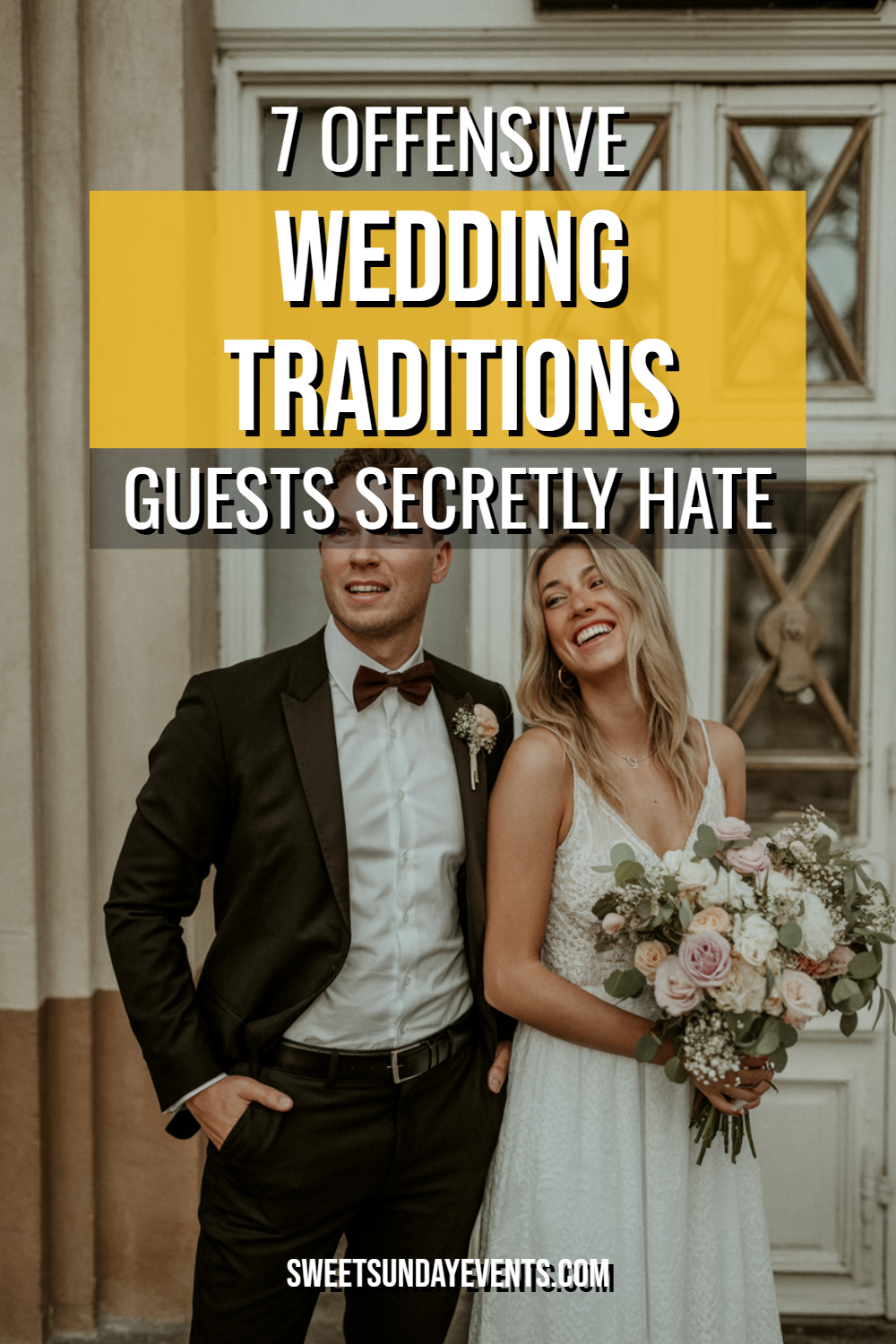Weddings are supposed to be joyful celebrations, but some traditions make guests squirm in their seats while forcing polite smiles.
After planning hundreds of weddings and hearing countless guest complaints, I’ve identified the most cringe-worthy practices that couples cling to without realizing the discomfort they’re causing.
1. The Bouquet and Garter Toss Double Feature
Nothing says “let’s make everyone uncomfortable” quite like forcing all single women to huddle together while a crowd watches them scramble for flowers.
The tradition itself feels outdated—like we’re still operating under the assumption that every unmarried woman is desperately waiting to be “next.”
The garter toss takes this awkwardness to an entirely different level. Watching the groom crawl under his bride’s dress while Uncle Bob hoots from the sidelines creates the kind of secondhand embarrassment that makes guests study their phones intensely.
Single men often hide in the bathroom during this spectacle, and honestly, who can blame them?
The Public Shaming Element
Both traditions essentially put people’s relationship status on display for public consumption. Your divorced aunt doesn’t want to explain why she’s not participating.
Your happily single cousin shouldn’t have to endure well-meaning but intrusive questions about her dating life.
The pressure to participate creates genuine anxiety for many guests. Some feel obligated to join in despite their discomfort, while others feel judged for opting out.
2. Mandatory Religious Ceremonies for Mixed Crowds
When couples incorporate lengthy religious elements without considering their diverse guest list, the result is often a room full of confused and uncomfortable attendees.
Forty-five minutes of scripture readings in a language half your guests don’t understand tests everyone’s patience.
The discomfort intensifies when guests are expected to participate in rituals they don’t understand or don’t believe in. Standing, sitting, reciting words, or performing gestures that hold no meaning for them feels performative and hollow.
The Inclusion Versus Tradition Dilemma
Couples often struggle between honoring their faith and including everyone meaningfully. The solution isn’t abandoning religious elements entirely, but rather providing context and making participation optional rather than assumed.
Consider printing brief explanations of rituals in your program. Let guests know when participation is welcome but not required, removing the guesswork and potential embarrassment.
3. Cash Bar Expectations at Expensive Venues
Nothing highlights poor planning quite like asking guests to pay for drinks at a wedding held in an obviously expensive location. The message comes across as “we had money for this gorgeous venue but couldn’t budget for your beverages.”
Guests already spend money on gifts, travel, accommodations, and often new outfits. Adding drink costs on top feels like nickel-and-diming people who are already investing in your celebration.
The Etiquette Mathematics
The general rule remains simple: if you invite people to a party, you provide the refreshments. This doesn’t mean you need an open bar with top-shelf liquor, but basic beer, wine, and signature cocktails should be covered.
Budget constraints are real, but there are creative solutions. Limit the bar hours, offer drink tickets, or choose a less expensive venue that allows you to properly host your guests.
4. Surprise Public Performance Demands
Springing karaoke, group dances, or “sharing a memory” moments on unsuspecting guests creates panic for anyone with social anxiety.
The couple might think they’re adding fun interactive elements, but many guests attend weddings specifically to celebrate others, not to become the entertainment.
The worst offenders are the “everyone must share” moments where the microphone gets passed around tables. Guests didn’t prepare speeches, and putting them on the spot often results in awkward rambling or visible distress.
The Voluntary Participation Solution
Interactive elements work beautifully when they’re genuinely optional. Set up a karaoke station for those who enjoy it, but don’t call people out by name. Create opportunities for sharing without mandating participation.
Consider a memory book where guests can write private messages instead of public speaking requirements. This gives people the chance to contribute meaningfully without the performance pressure.
5. Excessive Photography Restrictions
Demanding that guests keep their phones away during the entire reception goes too far. While unplugged ceremonies make perfect sense, extending the ban through dinner and dancing feels controlling and impractical.
Guests want to capture memories too, especially during milestone moments like their children dancing or multi-generational family interactions. Blanket photography bans prevent people from documenting their own experience of your celebration.
Finding the Photography Balance
Professional photographers need clear shots during key moments, but guests should be free to take pictures during social portions of the evening. Communicate specific times when phones should be away rather than issuing all-night restrictions.
The best compromise involves designated photo-free moments (ceremony, first dance, speeches) followed by open photography during dancing and mingling. This protects your professional photos while respecting guests’ desire to capture memories.
6. Lengthy Receiving Lines in Uncomfortable Locations
Standing in the sun, cold, or cramped spaces while waiting twenty minutes to exchange pleasantries with the couple tests everyone’s patience. Receiving lines often create bottlenecks that leave guests wondering if they should wait or just head to cocktail hour.
The conversations themselves become repetitive and rushed. By the time the couple reaches guest number fifty, everyone’s just going through the motions, making the tradition feel more obligatory than meaningful.
Alternative Connection Strategies
Table visits during dinner allow for more genuine conversations in comfortable settings. Couples can spend a few minutes with each table, creating better interactions than the assembly-line receiving line experience.
Post-ceremony mingling works well for smaller weddings where couples can naturally circulate among guests. This organic interaction feels more authentic than the formal line structure.
7. Competitive Gift Display Practices
Displaying opened gifts with cards attached turns your wedding into a public accounting of who gave what. Guests notice when their modest contribution sits next to expensive items, creating unnecessary social comparison and potential embarrassment.
The practice also invites judgment about gift choices and spending levels. Some guests agonize over their selections, worried about how their gifts will appear in the display context.
Gift Gratitude Without Competition
Thank-you notes serve the gratitude purpose without the public display element. Guests want to know their gifts were appreciated, but they don’t need their generosity compared to others’ contributions.
If you want to acknowledge gifts during the event, consider a general thank-you speech that expresses appreciation without specific mentions or displays. This shows gratitude while maintaining guests’ privacy and dignity.
Moving Forward With Mindful Celebrations
Planning a wedding that honors tradition while respecting guests requires honest evaluation of each element’s purpose and impact. The goal isn’t eliminating all customs, but rather choosing practices that enhance rather than detract from the celebration.
Consider each tradition through your guests’ eyes. Will this create joy or discomfort? Does it include or exclude? Will people participate willingly or feel obligated?
These questions help identify which elements truly serve your celebration and which might be better left behind.


